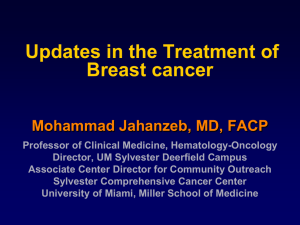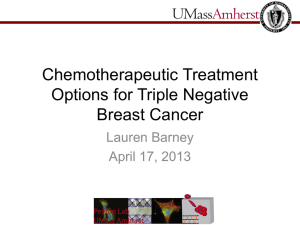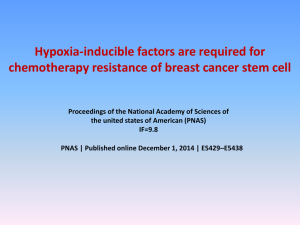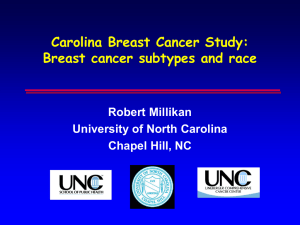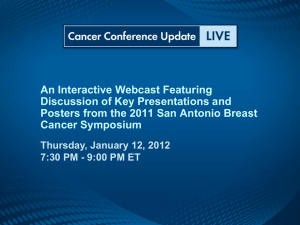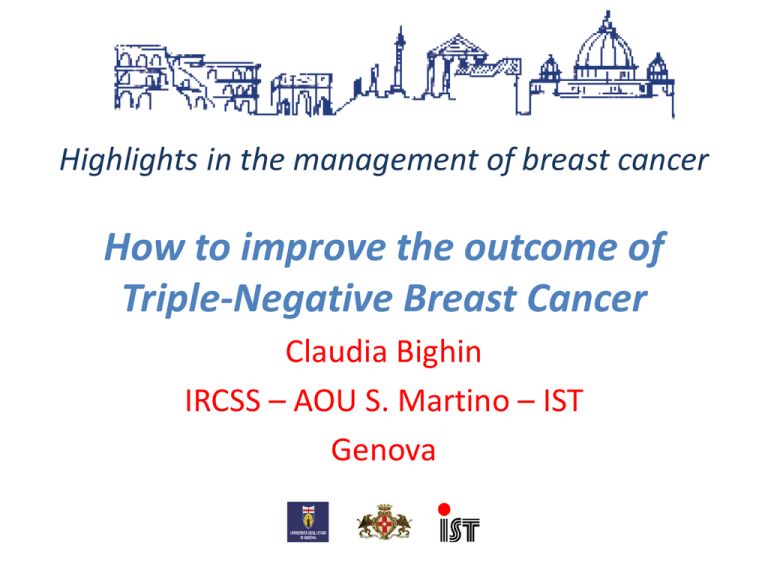
Highlights in the management of breast cancer
How to improve the outcome of
Triple-Negative Breast Cancer
Claudia Bighin
IRCSS – AOU S. Martino – IST
Genova
«From benchside to bedside»
Bed-side
Dissecting the Heterogeneity of TNBC
CK5/6, CK17
Metzger-Filho et al, JCO 2012
76% of the TNBC had
a BRCA1-like aCGH profile
Lips et al, BJC 2013
Good news from earlier stages?
Cheang et al, ASCO 2009
Cheang et al, ASCO 2009
Cheang et al, ASCO 2009
A-based vs CMF
according to molecular subgroup
(meta-analysis of 4 phase III trials)
CMF
1.06
1
0.83
*Triple negative
disease
0.82
0.77*
A-based
A-based vs CMF
0.67
HR: 0.77
95% CI 0.54-1.09
P value = 0.13
lB
(N
(N
=
=
7)
38
)
50
13
7)
18
4)
=
29
(N
=
+
(N
2
e
ER
tiv
H
ga
2)
ne
48
a
in
le
ip
Tr
m
Lu
=
lA
(N
a
in
s
pt
ll
m
Lu
A
Di Leo et al, Lancet Oncol 2011
TNBC/Basal-like
HER2 +
Luminal B
Luminal A
Hugh J et al. JCO 2009
Future perspective
Joensuu et al, Ann Oncol 2012
SABCS 2012
pCR predicts favourable outcome in
TNBC
pCR rates
Regimens
TNBC
NonTNBC
FAC/FEC/AC
20%
5%
TFAC/TFEC
28%
17%
Single agent
Taxane
12%
2%
The Paradox of higher sensitivity to neoadjuvant chemotherapy in poor
prognosis subtype (TNBC) is explained by the high relapse among pts with
residual disease
Liedtke C, et al. J Clin Oncol 2008
TNBC and pCR
von Minckwitz et al, JCO 2012
Ongoing neoadjuvant trial
von Minckwitz et al, Ann Oncol 2012
Bevacizumab
von Minckwitz et al, NEJM 2012
Bear et al, NEJM 2012
Phase II study:
FECwPaclitaxel + Bevacizumab
Clavarezza et al, The Breast 2013 (in press)
ASCO 2013
Breast Cancer Oral Session
• Abstract #1003
– PrECOG 0105: Final efficacy results from a phase II
study of gemcitabine (G) and carboplatin (C) plus
iniparib (BSI-201) as neoadjuvant therapy for triplenegative (TN) and BRCA1/2 mutation-associated
breast cancer. (Melinda L. Telli)
• Abstract #1004
– A randomized phase II trial investigating the addition
of carboplatin to neoadjuvant therapy for triplenegative and HER2-positive early breast cancer
(GeparSixto). (Gunter Von Minckwitz)
Median survival with distant metastases
Luminal A:
2.2 yrs
Luminal B:
1.6 yrs
Luminal/HER2: 1.3 yrs
HER2 enriched: 0.7 yrs
Basal-like:
0.5 yrs
3,732 EBC diagnosed between 1986-1992
Basal-like treated with adj CT: 48%
TNBC: Annual Hazard Rate of
Distant Recurrence
Peak of recurrence
• TN: 1 to 3 years
• Non-TN: steady risk over time
Dent R, et al. Clin Cancer Res 2007
Foulkes et al, NEJM 2010
Re-biospy?
Cardoso et al, The Breast 2012
TNBC:
“…Cytotoxic
chemotherapy remains
the mainstay of
treatment in this
group…»
Cardoso et al, Ann Oncol 2012
Newly approved drugs in TNBC
Agent
Ixabepilone1
Bevacizumab2
Eribulin3
Phase trial
TNBC pts
Setting
Results
III
433
+ Cape
Superior ORR and PFS
ORR: 31% vs 15%
PFS: 4,2 mo vs 1,7 mo
III (ECOG2100,
AVADO,
RIBBON)
621
+ CT
Superior ORR and PFS
ORR: 42% vs 23%
PFS: 8,1 mo vs 5,4 mo
OS: 18,9 mo vs 17,5 mo
III
144
Mono vs
TPC
Superior OS
HR=0,71
1 Rugo, SABCS 2008
2 O'Shaughnessy, ASCO 2011
3 Twelves, ESMO 2010
Targeted therapies
BALI-1 Trial
Baselga, SABCS 2010
The difference between the arms was not significant (p=0.11) and the ORR in the cetuximab
plus cisplatin arm did not exceed 20% (p=0.50; one-sided Z-test with a significance level
of alpha/2=0.05), therefore the simultaneous null hypothesis could not be rejected.
Baselga, SABCS 2010
Baselga, SABCS 2010
ORR < 20%
Carey et al, JCO 2012
Targeted therapies
Tutt et al, Lancet 2010
Tutt et al, Lancet 2010
O'Shaughnessy et al, NEJM 2011
[TITLE]
ORR 30 vs 34%
O'Shaughnessy et al, ASCO 2011
[TITLE]
O'Shaughnessy et al, ASCO 2011
Olaparib
Iniparib
Chuang et al, BCRT 2012
Can we find the Achille heel of
TNBC?
Can we sub-classify TNBC?
Pietenpol, SABCS 2012
Pietenpol, SABCS 2012
Pietenpol, SABCS 2012
Subtypes Characteristics
Subtype
Gene Ontology
IHC
analysis
Hysto type
Possible
sensitivity
Basal-like 1
Cell cycle and cell
division
DNA damage response
High Ki67
--
Cisplatin
PARP-Inhibitors
Basal-like 2
Growth gactor
signaling (EGFR, MET)
--
Medullary
Anti-EGFR
Immunomodulatory
Immune cell processes
--
--
Mesenchymallike
Cell motility and cell
differentation (TGF-β,
Src); GF patways
--
Mesenchymal
Stem-like
Angiogenesis
Low levels prolif genes
Claudin-low
--
Luminal AR
Hormonally regulated
pathways
AR +
Metaplastic
PI3K-mTOR Inh
(BEZ235)
Src-Inhibitors
(Dasatinib)
Anti-angio
Molecular
Apocrine
AR antagonist
Lehmann et al, J Clin Inv 2011
TNBC subtypes differ in RFS
• RFS decreased in LAR
subtype compared with
BL-1, IM and MSL
(p<0,005)
• Better RFS in BL-1
Lehmann et al, J Clin Inv 2011
Pietenpol, SABCS 2012
Shah et al, Nature 2012
Pietenpol, SABCS 2012
AR
positive
AR
negative
Pietenpol, SABCS 2012
West et al, BMJ 2013
ASCO 2013
Poster Discussion Session
• Abstract #1010
– Next-generation sequencing to find predictors for
chemotherapy response in triple-negative breast
cancer (TNBC). (Esther H. Lips)
• Abstract #1011
– Molecular identification of basal-like breast cancer
through genomic analyses across five cancer types.
(Aleix Prat)
• Abstract #1012
– NFKBIA deletion in triple-negative breast cancer.
(Markus Bredel)
Aparicio, SABCS 2012
How to improve the outcome of
TNBC?...at bedside
• Adjuvant setting
– Anthra plus Taxanes
• Neoadjuvant setting
CLINICAL
• Metastatic setting
TRIALS!!!
– Anthra plus Taxanes
– Re-biospy
– Bevacizumab
– Platinum salts
– Eribulin


